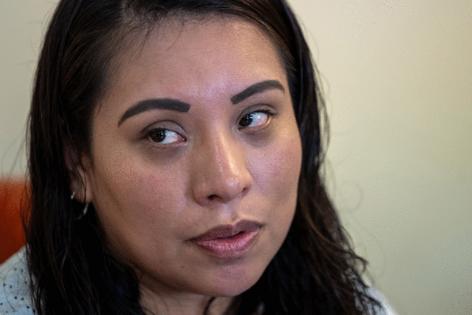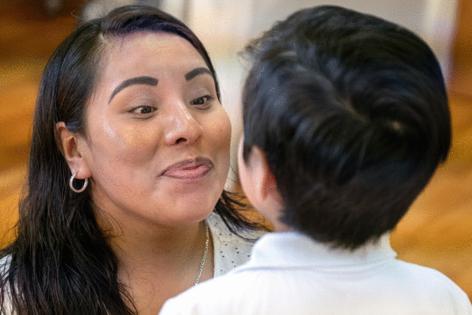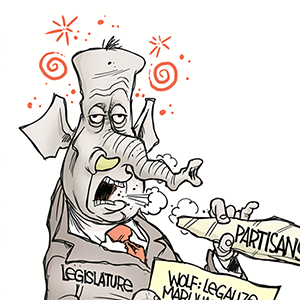Freed from ICE detention in Pa., but thinking of the women still inside: 'They are always going to be a part of me'
Published in News & Features
Andrea Lozano-Alanis was released from an ICE detention center more than a week ago, but part of her heart, she says, remains with the women she left behind.
Some have been inside the Moshannon, Pennsylvania, facility for months, and several phone her every day for encouragement. Others gave up their fight to stay in the United States and accepted deportation, worn down by isolation and hopelessness.
For Lozano-Alanis, 31, the undocumented mother of a 7-year-old autistic son, her battle is in some ways just beginning, her goals to be able to support her family, to try to stay in this country, to create a future.
She’s fighting not just for herself, she said, but for others like her, people who entered the United States with big hopes but no legal permission. Eight years after she came to this country, drawn by the prospect of a better life, the Trump administration is pressing hard to deport millions of immigrants, and the number of those held in ICE detention has gone up 15% in a month.
“You definitely aren’t the same person coming out,” Lozano-Alanis said in interview of her nearly three weeks’ detention. “But I hope to be able to make some change, something positive, because this really isn’t fair and it’s unjust.”
What had been a quiet, mostly anonymous life in Norristown, Pennsylvania, erupted into public view last month when Montgomery County jail officials held Lozano-Alanis even after her $77 bail had been paid, enabling ICE agents to come and take her into custody.
She had been arrested on criminal charges surrounding an alleged car-ramming incident in East Norriton.
After The Inquirer reported on her case, county jail officials dropped their policy and instituted a new one, saying the county will hold those who have posted bail only upon receiving a warrant that has been approved and signed by a judge.
County officials said they had been considering the shift for weeks.
Lozano-Alanis did not learn of the change until after she was freed from the Moshannon Valley Processing Center, more than 200 miles west of Philadelphia in Clearfield County.
“It made me so incredibly happy to know that the same thing wasn’t happening to other people,” she said through a translator. “To know I could have made that difference, and to see that now other people weren’t going through the same thing, was incredibly important.”
Arrival from Mexico
Lozano-Alanis came to the United States from Mexico in 2017, attracted by greater job opportunities and the chance for a better quality of life. A close friend lived in Norristown, the Montgomery County seat, so that became a destination, a place where she could build relationships and learn about life in a new country.
She described herself in the interview as someone sustained by faith. As a mother, to a son here and to two children in Mexico who live with her parents. And as a daughter to her own loving mother and father.
In fact, it was her mother, more than 2,000 miles away in Mexico, who alerted immigration advocates here that something was wrong, that Andrea was missing.
It started on June 3, when Lozano-Alanis allegedly ran her car into that of a romantic partner outside a Truist bank in East Norriton.
Police arrested her on charges that included child endangerment because her son was in the car. She also was charged with recklessly endangering another person, careless and reckless driving, and driving without a license.
She was held at the Montgomery County Correctional Facility.
Meanwhile, Lozano-Alanis’ mother had become concerned. She talks to her daughter every day, usually several times a day, and now her child had gone silent.
The mother contacted Unides Para Servir Norristown, the advocacy group, which worked to locate Lozano-Alanis. Members of that group joined with others who went to the jail on June 6, hoping to bring her home.
Supporters pay her bail
Supporters paid Lozano-Alanis’ bail, but the jail refused to release her. ICE had issued a detainer, an agency request to hold people beyond the time that they would normally be freed.
Montgomery County administrators followed their policy of holding immigrants sought by ICE for up to an additional four hours.
That enabled agents to arrive at the jail and arrest Lozano-Alanis — provoking a huge outcry. Activists demanded to know what right the county had to hold someone who had met her bail conditions, particularly when other jurisdictions have been successfully sued for doing exactly that.
Some places, including Philadelphia, refuse to honor ICE detainers unless they are accompanied by a signed judicial warrant.
Montgomery County jail officials subsequently dropped that policy, saying they would now hold those who posted bail only upon receiving a warrant that was approved and signed by a judge.
That change came too late for Lozano-Alanis, who had been confined at the 1,876-bed Moshannon center, the largest of four Pennsylvania detention facilities.
Life there was dismal, Lozano-Alanis said. She and other women were routinely demeaned by staff members who called them “stupid” and “bitches,” in jail “because of your own doing,” she said.
When friends call her from inside, she said, she encourages them to keep going, to not give up, to try to fight for the ability to stay in this country and make a life for themselves.
ICE officials did not provide comment before deadline.
Among the hardest parts of detention, Lozano-Alanis said, was trying to explain to her son, “For him to ask me, ‘Mom, where are you? When are you coming home? When am I going to see you?’ … And I didn’t have an answer for him.”
Expanding ICE arrests
Federal immigration authorities have little sympathy for those who cross the border without government approval. President Donald Trump has worked to expand removals and increase daily arrests, pushing a narrative that Immigration and Customs Enforcement is going after criminals and lawbreakers.
As of mid-June, ICE was detaining more than 56,000 immigrants around the country, up from about 49,000 a month earlier. Statistics show 72% have no criminal record.
The Trump administration named Montgomery County to a list of so-called sanctuary jurisdictions from which it wants to cut federal funding. And Norristown, where one in three residents is Latino, has been a target for ICE, with agents arresting more than 20 people there in late May and June.
ICE continues to operate in the county, with advocates reporting activity in East Norriton on Monday, and in Norristown, Pottstown, and King of Prussia in preceding days.
Lozano-Alanis spent 18 days in custody before being released on June 24, after supporters raised and posted her $5,000 immigration bond. Authorities dropped all criminal charges.
Deportation proceedings loom
She still faces federal deportation proceedings, for which no date has been set. Being freed on bond is important for undocumented people, because it enables them to have greater access to attorneys and supporters.
“The only thing that I can do is put my faith in the hands of my lawyer, in the faith of God,” Lozano-Alanis said. “I continue to fight this case, mainly for my son, who (needs) medical attention.”
Soon after the Montgomery County jail changed its detainer policy, the county commissioners installed new rules that limit how employees can share information with federal immigration authorities.
Lozano-Alanis wants them to do more, to enact a “Welcoming County” policy to support all immigrants. The Democratic-led board has resisted, citing limits on its power and concern about creating false hope in immigrant communities.
Legally, no local policy or ordinance can block ICE from enforcing federal immigration laws.
Lozano-Alanis recently moved from Norristown, but did not wish to say where she is living. She is being supported by friends but knows that cannot continue indefinitely.
She worries about finding a job, having previously worked as a chef in the Philadelphia area. And she worries always about the women she met at Moshannon.
“I’m trying to come back to the basics of what my life was like before, but it’s incredibly different,” she said. “One of the things that’s weighing heaviest is, ‘What can we do? What kind of unity can we create?’ Especially for the women that are still in there.”
_____
©2025 The Philadelphia Inquirer. Visit inquirer.com. Distributed by Tribune Content Agency, LLC.










Comments